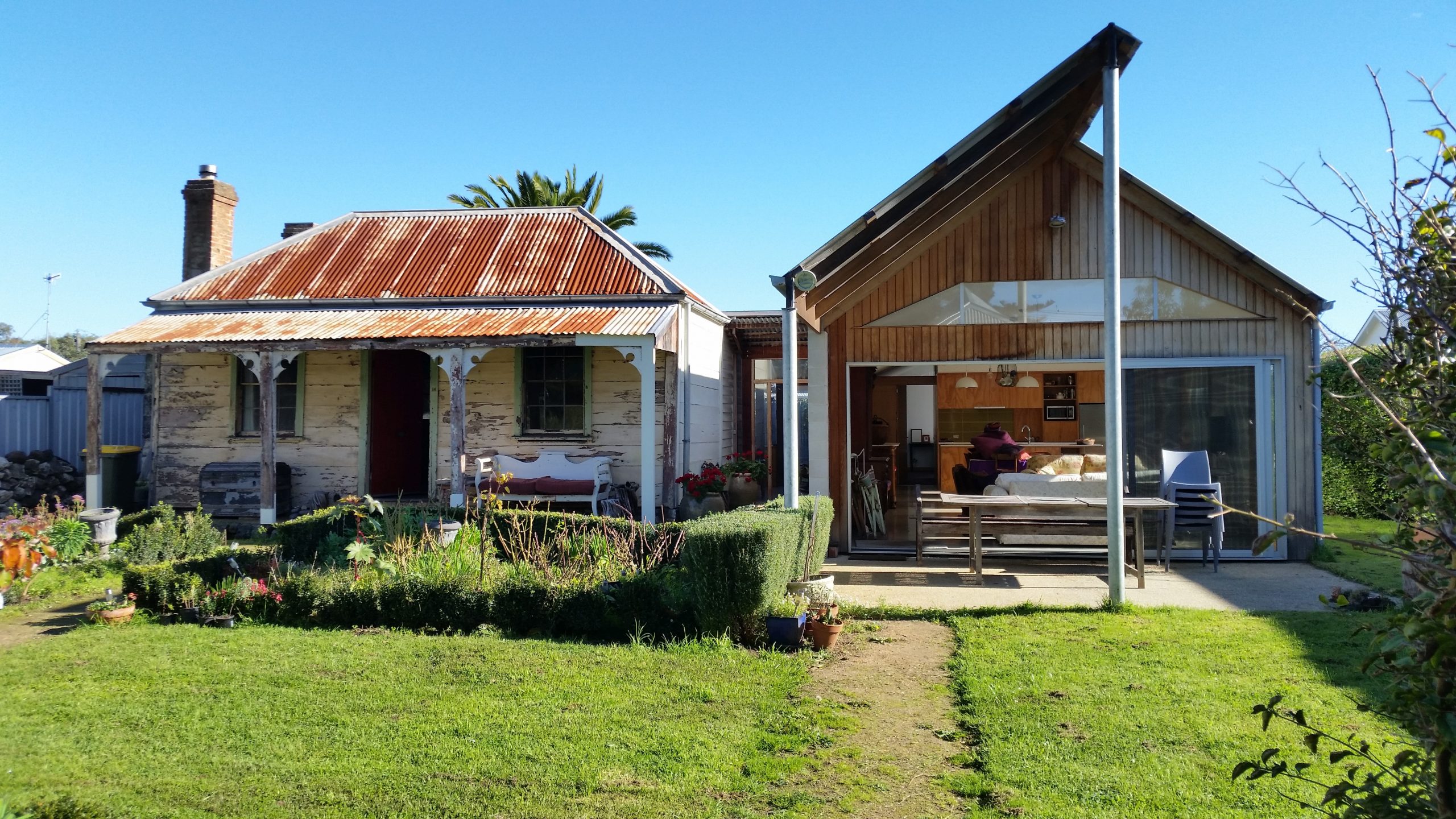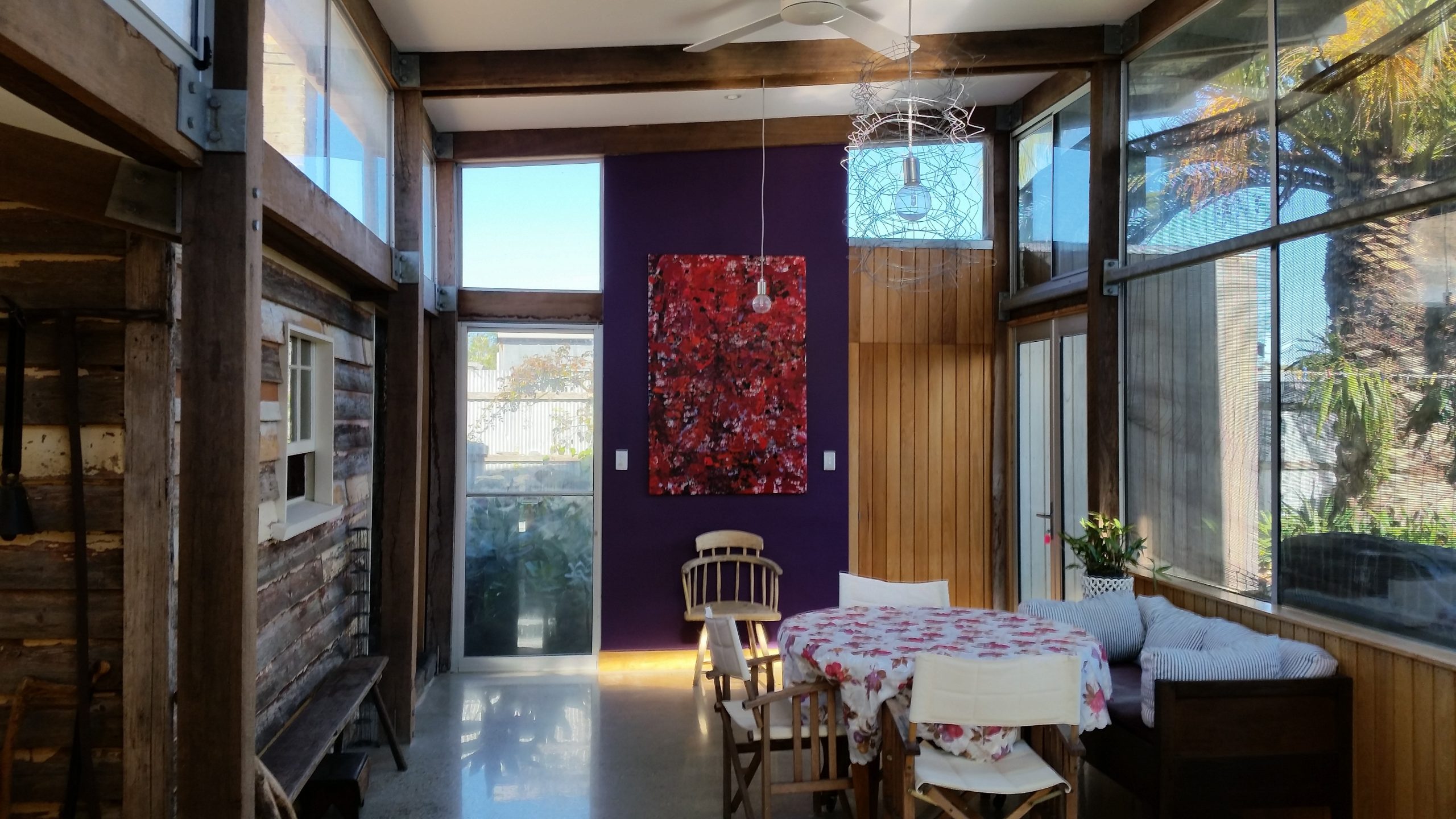Heritage Listing: Victorian Heritage Register
Kell Cottage is a small cottage in Port Fairy, listed in the Victorian Heritage Register. The heritage property was intact but dilapidated prior to the new work, which has revived and reinvigorated the cottage and garden and added contemporary living spaces to the side and rear. The charm, character and retained patina of the historic cottage is central to the experience of the new home.
Download a printable version of the Kell Cottage Case Study (PDF 3MB).
Significance of the place
Kell Cottage is recognised for its historic and architectural significance. It is listed in the Victorian Heritage Register as an “excellent and intact example of a simple timber dwelling from the late 1840s.” The few modifications that have been made over the life of the building can be identified and dated. This means that cottage is an important reference for vernacular construction methods, timbers, hardware, materials and decorative finishes in mid-nineteenth-century Australia. The cottage is also historically significant for its association with the early development of Port Fairy.
Opportunities
When purchased by the current owner, the small cottage was derelict. Since it was built (between 1847 and 1852), it had had only four owners. Minor alterations had been made over time, with some new surfaces and materials added, but very little had been removed. The new owner, a heritage architect, likens the property to a gracefully ageing older woman: “the surfaces were wearing, cracks and wrinkles were showing and balances were stumbling.” The building fabric, tattered in places, evoked the life of the building over the previous 170 years. The materials – basalt rock on the surface for footings, timber mortice and tenon stud frame, and 25 x 270 mm tongue-and-groove weatherboard – were durable and robust, able to be repaired and revived while maintaining their character, quality and the heritage values embodied therein.
The property was large enough to accommodate an addition that houses contemporary domestic needs, thereby allowing the cottage to remain intact and continue aging gracefully (while being appropriately maintained to avoid future damage).
Challenges
The cottage comprises four rooms, which were small and awkward as main living spaces by contemporary standards. The simple plan arrangement – two rooms at the front, two smaller rear rooms in a lean-to, with no internal corridors or circulation – was also a potential challenge. However, the overall approach has meant that they can take on a new life within the extended home.
Approach and outcome
The approach to the property has two core aspects – the planning of the entire site, and the care of the heritage building, materials and details. These work together to create a pleasant and engaging home that supports the heritage values and significance of the property.
The conceptual approach to the heritage building was to care for and stabilize the building fabric using a very light touch. The cottage was repaired as needed. The leaning structure could not be straightened, so the crooked wall was braced in place. Exposed worn surfaces were patched and sealed, and the whole was cleaned to a hygienic standard. Finishes on surfaces that are protected from the weather were left as-is, while those that are new or exposed were painted.
Inside, some additional layers have been removed, while others have been retained as part of the ongoing life of the property. For example, the hardwood timber floors were stripped of additional coverings and nails and tacks removed. The timber was then scrubbed and waxed, and the architect/owner comments that, “with a buff, the floor gleams, although creaky”.
The cottage had 30 different wallpapers layered across the four rooms. These have been retained in some rooms, but in the front parlour a new layer of 1850 reproduction wallpaper has been added over the top, in a design that is very similar to the original second layer. A later bathroom had been slotted into place and was easily removed to reveal the earlier split lining boards.
The approach to site planning and the design of the alteration enables and supports this respectful care of the heritage fabric. The block has been conceptually split in two – on one side is the 1840s part, with cottage and a period garden in front, the other is clearly from the twenty-first century – a new, energy-efficient building surrounded by a simpler lawn, with a garage concealing it from the street. The new structure, containing living spaces, kitchen and a bedroom, runs parallel to the cottage and wraps behind with a sunroom, bathroom and laundry.
All amenities and services are housed in the new extensions, meaning that very few interventions were required in the heritage fabric.
The four cottage rooms are used as a sitting room, a study and two guest bedrooms. As a couple, the owners live throughout the whole house, using the sitting room and study in winters with the wood-fire box.
The two buildings that comprise the house are clearly distinct, gently balancing each other. The addition is proudly ‘new’, but responds and relates to the old in terms of scale and materials. The worn, weathered cottage walls form one side of the sunroom, but all new materials – timber, concrete block and corrugated iron – are crisp, neat and ‘tidy’. From the street, the new addition recedes behind the garage and garden planting, while the central path and ordered garden beds frame the view of the cottage.
Lessons
- The ‘light touch’ approach to repairing and stabilising the cottage has maintained many layers, ensuring that the home continues to tell its stories.
- Careful planning of the whole site has created a clear relationship between old and new, which is also reflected in the garden design.
- Housing all amenities in the addition reduced interventions needed in the heritage cottage.
Project team
Architect: Brendan O’Toole




